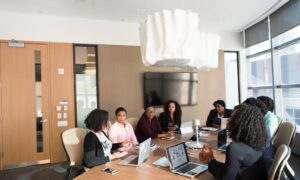A strong online presence is your brand’s visibility across the web – including websites, social media, local business directories, contributor platforms, forums, and Q&A resources. The first step is laying the foundation of site architecture optimized for search visibility and clarity.
The next step is meshing an on-brand, engaging look with design elements that convert. This is where a professionally designed website, companies like Avenue 25 provides shines.
Colors
The right web design colors can captivate your audience, communicate your message, and enhance user experience. The key is understanding the psychology behind colors and how they can communicate different messages and evoke emotions. By using contrasting colors and creating a visual hierarchy, you can guide your users through a website, making it easier to find the information they’re looking for and take action on your site.
The first step to creating a visually striking online presence is understanding the demographics of your target audience. These demographics can impact color preferences and associations, so knowing your audience well is important to select the right colors for your website. For example, warm colors like red, orange, and yellow evoke energy and excitement, effectively attracting attention and highlighting call-to-action buttons on your website. Meanwhile, cool colors like blue and green evoke feelings of trust, calmness, and professionalism, which can be appropriate for content that requires a more professional tone.
Once you understand the psychology of colors, it’s important to consider how they can be used in your website. For instance, complementary colors—those positioned opposite each other on the color wheel—provide a strong visual contrast and can draw attention to specific elements on your site, such as a call-to-action button or an important message. In addition, it’s also crucial to consider accessibility when selecting colors for your website, as there must be sufficient contrast between the background and text to ensure that users can read your content without strain.
Typography
The text in a web design Phoenix is an important element that can create a visually striking impact. It is also a tool for conveying the message, setting the tone, and enhancing readability. It is important to choose a font that is easy for viewers to read, and it is also essential to ensure the text is aligned correctly and not overcrowded. There are many types of fonts, and it is helpful to know the difference between them to make the best choice for your project.
There are many different ways to use typography in a design, and it is a very versatile tool that can be used for any purpose. For example, you can use it to add an element of sexiness to your design, or you can use it to emphasize certain words in your content. It can also create a sense of urgency or importance in your design. The fonts you choose can greatly impact your design are one of the most important aspects of good web design.
In addition to being an effective communication tool, typography can create harmony and consistency in a design. This is particularly important in branding, as it helps to build recognition amongst customers and visitors. A great way to do this is using the same font throughout your website.
Typography has a long history, dating back to the 11th century when the innovation of movable type was first introduced. Since then, it has become an important part of design and has been incorporated into countless works of art. There are many types of fonts, from script to display, and it is important to understand the differences between them to make the best choice in your design project.
Images
The images on your website play a key role in shaping user experience, establishing brand recognition, and driving business growth. They’re a way to create a visual identity for your brand and connect with potential customers meaningfully and meaningfully.
To achieve a visually striking online presence, choosing high-quality photos and videos is important. Images should be clear, easy to read, and complement your logo and color scheme. Avoid choosing too bright colors, as they can be hard on the eyes. Similarly, use only a few fonts, as this can make your website look busy and unorganized.
Hero images are large, visually striking images that appear at the top of a page. They serve as a focal point and are an effective tool for engaging users, conveying your message, and delivering a positive user experience.
Contextual hero images are a great way to show the use of your products or services and help users envision themselves using them in real-world scenarios. For example, Decathlon, a sports equipment retailer, uses contextual hero images to showcase their products in outdoor settings. This helps users connect with their brand and envision using their products on their next hiking adventure.
Non-contextual hero images are a great alternative to contextual hero images and can be as effective at capturing attention. These images can be more creative and abstract, often aiming to evoke emotions or spark curiosity in the audience. For example, the image of a dog on the homepage of Subtraction is an eye-catching visual that immediately draws the audience’s attention.
Animations
Whether used sparingly or liberally, animations are an effective web design tool that can elevate user experience and leave visitors with a memorable impression. However, animations must be carefully planned to ensure their effectiveness and usability.
From capturing attention to explaining complex concepts, the right animations can create a seamless and impactful web experience. But, it’s important to remember that animation can also become distracting or overwhelm users, so it’s best to avoid using them excessively or with unimportant content.
Subtle animations add an element of finesse and polish to the website and make it feel more professional. They can illustrate different steps in a process or concept, draw attention to important content, and convey a sense of professionalism and trust. In addition, they can enhance interactivity and provide interactive feedback for users.
More elaborate animations can keep visitors engaged, ultimately increasing site time and reducing bounce rates. This can also lead to improved search engine rankings.
Loading animations and progress indicators can help users easily navigate websites, as they provide visual feedback during the loading process. These are essential for ensuring a positive user experience and preventing frustration from slow-loading pages.
Illustrations can add personality and evoke an emotional response in users. But, it’s crucial to ensure that illustrations align with the brand and website messaging. Outdated or irrelevant illustrations can make the website appear outdated and stale, diminishing the user’s experience. Regularly reviewing and updating illustrations can keep them fresh and engaging. This shows that the business is active and cares about its customers and their experience.
Layout
A good layout can help you stand out online. It’s important to keep your website’s design elements like colors, fonts, images and shapes consistent. This makes the site look professional and helps viewers quickly recognize your brand’s identity. A consistent look also gives the viewer a more comfortable experience by helping them find what they’re looking for without getting overwhelmed.
Layouts are a way to organize and present information in a way that is easy for the viewer to understand. They typically use a grid to create balance and order in a design. The grid provides a structure that helps the designer focus on important elements and makes them stand out. This is especially helpful when creating a text-heavy design. For example, a newspaper layout uses columns to arrange headlines and articles, making it easier for readers to navigate the news.
In addition to using a grid, a great layout should consider the proximity of different elements. Proper proximity helps the viewer distinguish the different parts of the design and allows them to identify important information easily. It’s also a good idea to use white space to separate the different sections of the design.
A strong online presence is essential for businesses and brands wanting to be noticed digitally. It increases the chances that your business will be chosen over competitors, builds trust with potential customers, and can increase sales. However, a strong web presence is something that takes time to happen. You and your team require consistent work, attention, and effort. It’s essential to have a plan and a schedule for creating content and updating your website regularly.

















